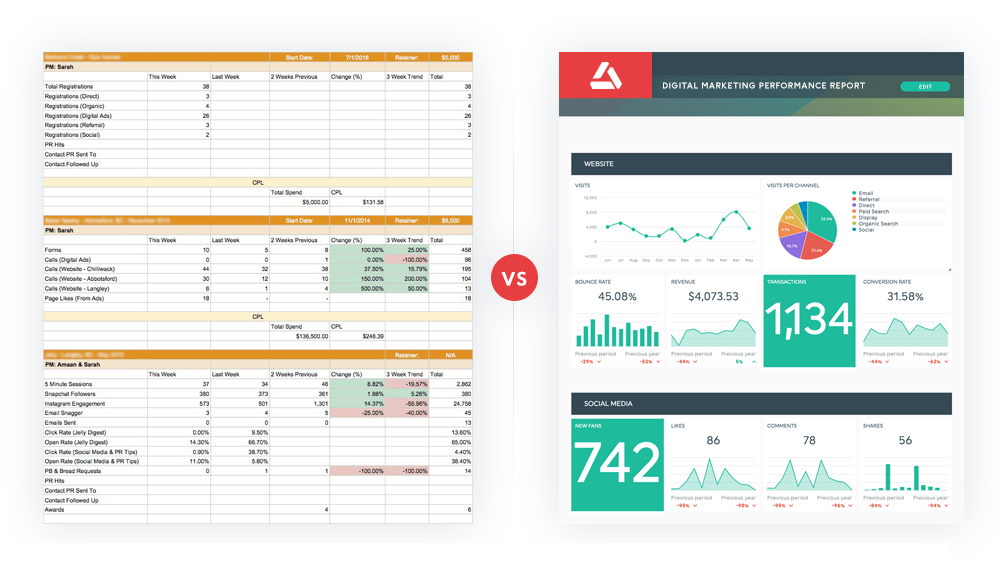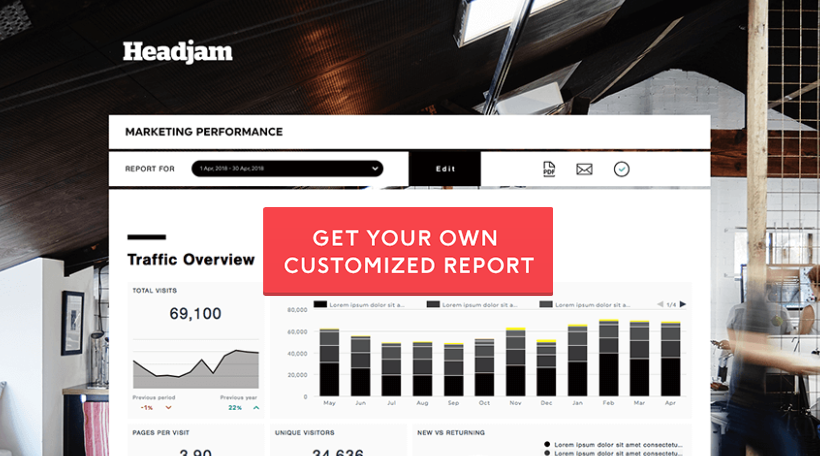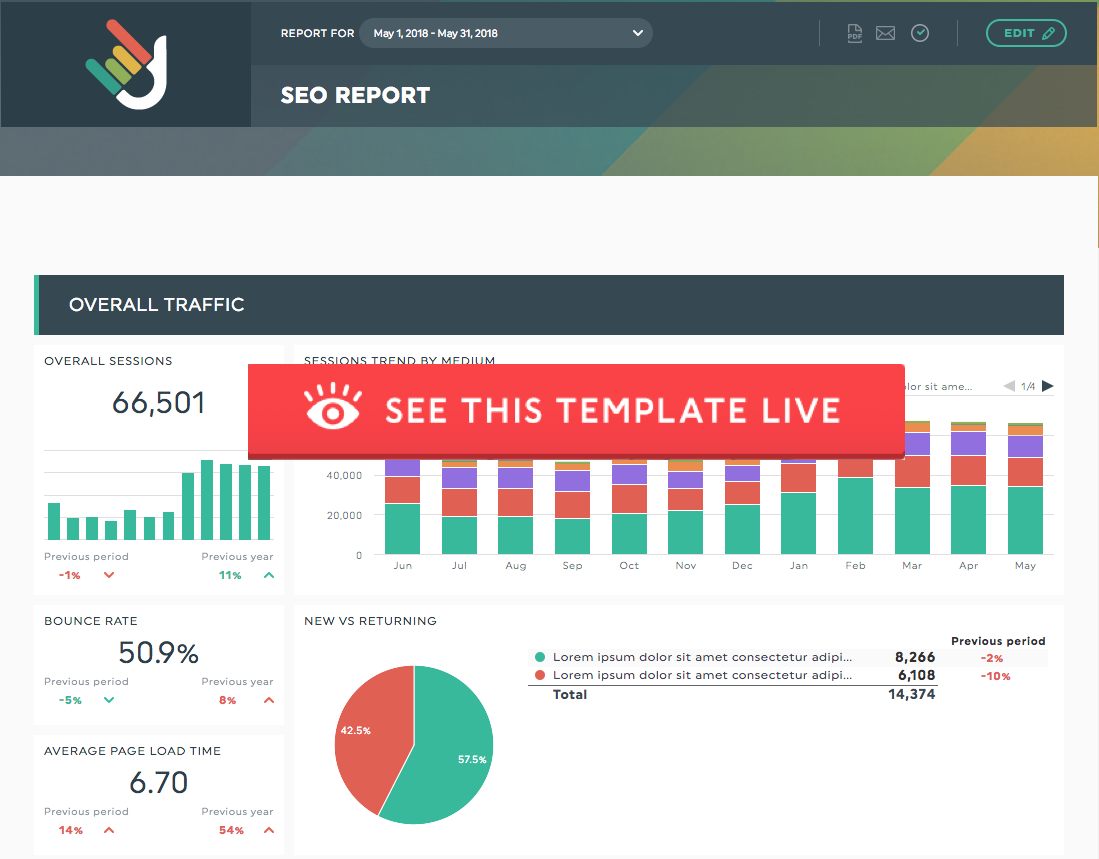Agency reporting: 15 best practices you need to know about!

You want your marketing reports to rock, to give your agency that je-ne-sais-quoi, to look fantastic, and to be efficient. Right?
I’m here to help you get there!
To bring your reporting game to the next level, here are the 15 best practices you should remember when creating your agency reports!
Let me break it down for you.
Why is agency reporting SO important?
Agency reporting is basically your bread and butter.
Without reporting, how can your agency demonstrate its performance?
How can you show that your brilliant strategy worked out?
How can you prove to your client that your agency is well-worth the investment?
You can’t!
As marketers, we all know that communication is key to any client-agency relationships!
And an agency’s reporting is the perfect way to open and maintain discussions with your clients.
Agency reporting can also help you explain to your clients what you’re doing to help their business and how you’re going to achieve their goals. This is crucial because clients who understand all the work you do for them will appreciate your agency a lot more and therefore keep doing business with you.
You don’t believe me? Ask Darian from Jelly Marketing:
“Reporting is everything in the world of digital marketing. It is how our work is measured with clientele, and it’s how we continuously evaluate campaign strategy internally for our client portfolios.”
- Darian Kovacs, Jelly Marketing
If you think reporting is too tedious, that it’s a waste of precious time that you could otherwise put on your marketing strategies, think again! Nowadays, it can all be done automatically! All you have to do is use an automated reporting tool.
Now, what should you do to create awesome reports for your clients?
Follow these 15 agency reporting best practices and you’ll be golden:
The 15 agency reporting best practices
1. Display the most relevant data first
If your clients have to search through the entire report to find the data that pertains to their main goals, it’s a waste of their time, and nobody likes wasted time! Your clients should know what’s going on with their digital marketing objectives in the blink of an eye.
So, make sure you put all the most crucial data up front in your agency report. Usually, clients will want to know how much they spent, if it paid off (sales, leads, traffic), and their ROI. All other information and campaign details can take the back seat on page 2 or 3.
2. Add notes to your report’s data
If there was a sudden drop or spike in one of your KPIs, add a note next to that KPI in order to explain it right away. You don’t want your client to start panicking about a normal variation.
It’s important that your notes are directly attached to the data in question, instead of lost at the bottom of a footnote 3 pages later. It’ll make it easier for your client to see it and understand it right away.
3. Explain your results
Don’t just send your report and call it a day, give your expert opinion on your results.
Was it a good month? Are we heading in the right direction? What happened that’s worth mentioning? Your clients want to know! Write your insights either at the top or bottom of your report, describing briefly what should be understood from this month’s data.
4. Add images to your reports
Add images to see exactly what we’re talking about.
In a marketing report, it can be hard to picture which ad is bringing the most traffic or sales without some context. Images are an easy way to solve this problem. Adding pictures of your best performing ads gives a better idea of what works best visually for your client, which can then help them with future decisions.

5. Display your report’s data in sections
To have a clearer and more readable report, make sure to add sections and headers.
Your clients will be able to navigate efficiently through the report and get to the information they want quickly. For example, you could have a summary section on the first page, followed by social media, PPC, and SEO sections.
6. Add some perspective to your reporting
Reassure your clients with an overview of what’s been done in the past and what’s next.
Since marketing strategies can take some time before they start paying off, it’s important to list your previous actions in relation with today’s results. It can also help to give your client perspective in situations like a recurring traffic drop during holidays. You should also include some insights about your next steps regarding the different projects. Your clients will be reassured and know exactly where your strategies are heading.
7. Customize your agency’s reports
Don’t you want to make a stunning first impression?
Make sure you customize your reports to fit either your own agency’s branding, or even better, your client’s. You could just add a logo, or go all-in and create a white label report with custom URL, colours, background, and more. It’ll look more professional and give you an advantage over competition.
8. Plan for your reporting
Reporting can take several hours over the course of your month, so carve out time in your schedule to create great reports.
Make sure your create the reports your client deserves; don’t wait until the very last minute, rushing to get something done. If you don’t have enough time to dedicate to your reports every week or month, you can use an automated reporting tool that will do all the heavy lifting for you. You’ll get great reports in no time.
9. Gather all your data in the same report
It can be quite confusing for your client to have a report for each data source.
You create campaigns on different websites, social media networks, and advertising platforms, but your clients need to know their overall costs, gains, and ROI. Having everything displayed separately in different reports isn’t very helpful. Instead, gather all this data into just one, easily understandable report. To make it extra simple, use a tool that can do the math for you and create your all-in-one report automatically.
10. Create an online report
Wouldn’t it be great if your clients could access their up-to-date data, on their own, 24/7?
What if I told you that it’s actually very easy to do! Just create an online agency report that updates itself automatically and give them the URL. This way, they won’t have to call you to have their latest results, and you won’t have to fetch the data each time they need an update. Win-win!
11. Present your data in a visually pleasing report
Nobody wants to receive an ugly excel spreadsheet with never ending lists of numbers.
Not only is it dizzying, but it’s hard to digest. If you want your clients to read and understand your reports, present them with a visually pleasing and dynamic layout by adding some easy-to-read graphs and charts, instead of a simple table of numbers.

12. Use your reports as tools for discussion
You should use your report as a way to start a conversation with your client, but it shouldn’t be the only occasion when (s)he hears from you.
So make sure you do a follow-up after sending your reports: see if your client read it, understood everything, and if (s)he is feeling good about the results and upcoming projects. If you don’t have time to do a follow-up after each report, schedule them quarterly to make sure you don’t forget.
13. Add some diversity to your report’s graphs
You don’t want your clients to fall asleep while looking at your unreadable report don’t you?
To have a dynamic and easy-to-read report, make sure you don’t always use the same type of graph. Use different formats: bar charts, line graphs, tables, pie charts, lists, numbers, doughnuts, everything!

14. Simplify your reporting life by using templates
Don’t hesitate to use report templates to jump start the reporting process; you’ll get all the most important KPIs you need according to your report type, without even thinking about it.
Once the base of your agency report is made, you can simply customize your report to the particularities of each client.
15. Have an automated email dispatch system
Save hours of work every month!
Use a reporting tool that has the option of scheduling an email dispatch. Your reports will be sent automatically every month with the updated data. If you forget, are sick, or on vacation, your reports will still be sent!
Agency reporting doesn’t have to be time-consuming!
There you have it!
The 15 best practices you should definitely keep in mind for your next reports. Ready to impress your clients? To improve your reporting game?
What are you waiting for?
You want to have perfect reports, take the time to discuss with your clients, build a good relationship. But excel spreadsheets and manual data fetching, ain’t nobody got time for that!
Count on our automated reporting tool to do all the tedious work for you, so that you have all the time in the world to focus on what really matters: your clients.
Relax, grab a cocktail and let us handle it from here.
Ready to automate your reporting?
Read More
Don’t miss out!
Automate your reports!
Bring all your marketing data into one automated report.
Try dashthis for free



